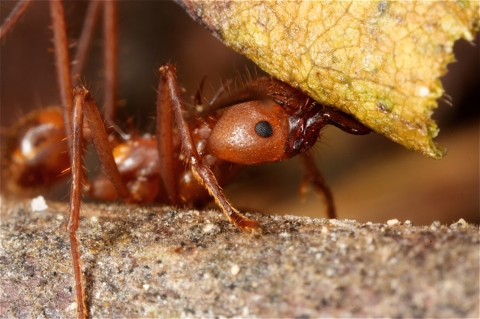This week we are excited to feature a series of articles about some of the most important landscapes the U.S. Fish and Wildlife Service helps to protect in Central America, that are home to an incredibly biodiverse array of wildlife. As part of “Central America Week,” we invite you to learn more about our cornerstone strategy with Wildlife Conservation Society to protect Central America’s five largest remaining wild places. We will also be spotlighting some of the charismatic species that live in these critical habitats.
One of the species we are featuring as part of Central America Week might not be as well-known as a jaguar or howler monkeys, but not because they lack charisma or talent. It’s actually because they are really tiny; they’re ants! Here are 5 fascinating facts about leaf cutter ants!
1. Leaf cutter ants have a specially adapted jaw that “saws” off pieces of plants. These chainsaw mandibles vibrate a thousand times per second! If you listen close enough, you can hear the Jaws theme song playing. Okay, not really.
2. These ambitious ants appear to bite off more than they can chew, but they can actually carry pieces of leaves almost 50 times their own weight. That’s like a human carrying a car! Talk about pumping some iron. Get it? Cause leaves have iron in them… aha.
3. It’s not even for their own edible enjoyment that they carry these comparatively gigantic hauls of vegetation to their homes, but for the growing of their own fungus gardens for food harvesting. Yum, fungi.
4. When these ants go marching, it is mesmerizing to watch their impressively choreographed routines. The leaf cutter ants have highly complex and functioning societies, with millions of members separated in different functional roles, called castes, including soldiers, workers, the queen and even a garbage crew.
5. Finally, they contribute a great deal toward important scientific discoveries, like research for better drugs and alternate forms of energy. In fact, they carry bacteria with antibiotic properties on their bodies for healthy gardening purposes. Living on cellulose, they also inspire clean energy alternatives through biofuel research. We might have a lot to thank these micro farming pharmacists for in the future!
Story by Betsy Painter, International Affairs.
This story is part of our Open Spaces blog.




